ITAZUKE - FUKUOKA
Bud Farrell
Itazuke Air Base near Fukuoka, on the southernmost Island of Japan, Kyushu, was our emergency base and a small travel adventure for us after a mission, even if it meant nothing longer than a refueling or minor repair stopover on the way back to Okinawa from North Korea. A small Air Base Operations area caf? served ham & eggs for 25 cents and as soon as a diversion to Itazuke was declared, the pronouncement of that simple pleasure went out over interphone ... "ITAZUKE ... HAM AND EGGS!"
On July 30th after the Max Effort to Sinuiju and the Oriental Light Metals Works, just across the Yalu River from Antung, the huge Manchurian Mig - 15 sanctuary, we had lost our # 4 engine and could not hold our briefed bombing altitude of 22,500 feet and went over the target at a very vulnerable 14,000 feet, had intense flak and searchlight activity but no damage of any consequence. With no urgency warranting the risk of a long over-water crossing back to Okinawa on just 3 engines, and always some possibility of losing another engine, discretion dictated our going into Itazuke, where FEAF ( Far East Air Force) maintenance operations were equipped and manned to make major repairs on transient B-29s.
Having determined that our ship would require an engine change that would take a day or two, we were issued special passes to go into town in our flight fatigues, coveralls, rather than the usual "Class A" OR "B" required uniform of dress khaki's. Our combat crew regulations precluded us from carrying wallets, money, personal effects, letters, etc, other than standard G.I. type dog tags. Of course most of us were in violation of this regulation to some degree, with letters and photos just received, and read and probably reread many times on our way north that night. On this mission, Lt.Carl Merritt, our Radar Observer, had carried his wallet and had sixty dollars which he very graciously divided up among the twelve of us, our crew of eleven plus the Group E.C.M. man flying with us that night ... a lavish 5 dollars per man to last us one or two days in Fukuoka ... .UNTIL the 6:00 P.M. strictly enforced curfew!
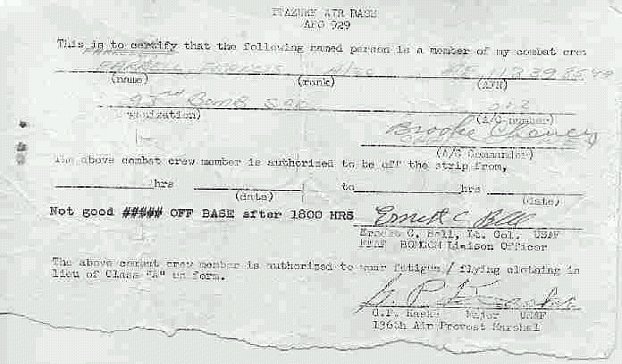 |
Needless to say, not knowing then whether we would ever get another chance to "see Japan", we went to town early in the day after a short crew briefing by our A.C., Capt. Cheney, regarding the probable repair status of our aircraft. The limitation of funds- and uncertainty of our duration there- imposed a thriftiness that might otherwise have not existed. We had just enough to get to town, have an Asahi Beer or two, and wander the streets and alleys enjoying the local color. When some of us needed cigarettes we found that the local black market for American cigarettes was thriving, with "Luckies" costing far more than the 15 cents a pack available back on the base, so we settled for Sinsei cigarettes while the natives were smoking our Luckies ! These cigarettes were far worse than something I might have rolled for my parents during World War II with a little machine that wrapped paper around a pinch of tobacco, most of which fell out of the wrapper when held end up or down! The old term of "weed" was quite appropriate and DRIED weed even more so!
While in Fukuoka, in our Flight Fatigues, our strolling was interrupted several times by Military and Air Police in sudden screeching stops of jeeps with big whipping antennas ... their occupants going "APE"... "Where the hell do you think you're going looking like that?" We reveled in telling them "To the Yalu River!" ... and they then somewhat more humbly said "OK" ... after we coolly flashed our special combat crew passes ... like Seinfeld at that gas station pump with his American Express Card in that stupid commercial.
At the end of the day as we waited for a bus, since we could not afford the luxury of a cab to return to the base before curfew, we waited on a corner in front of a four or five story building under repair of WW II bombing damage. As we waited, a brick shattered on the sidewalk right next to us but we passed it off as an accidental dropping by a workman high on the scaffolding until another brick fell nearby! At the crash of a third, we finally spotted the culprit, a Japanese worker who ducked back behind the wall about four floors above. We belatedly learned that while the Japanese tolerated the American fighter aircraft and the personnel stationed at Itazuke, and the relatively high paying jobs that came with them, they truly detested the incursion of the B-29's returning from North Korea and laying over in their Fukuoka backyard ... which was just about midway between Hiroshima and Nagasaki, the recipients of the first and only Atomic Bombings in the world ... by B-29s!
21st Bomber Command Dispatch June 19, 1945... "The USAAF's XXI Bomber Command in the Marianas flew four missions, one mining and three incendiary missions against secondary cities, during the night of 19/20 June. Mission # 211: 221 B-29s attack the Fukuoka urban area destroying 1.37 square miles; two other B-29s attack alternate targets." Posted by Tom Robison, June 19th ,2004 |
Their hatred of the "BINIJUKU" -B-29 (Be-nee-chee-ku- Phonetic Japanese pronunciation for B-29) - was just over six years old and had already been reflected in their vengeance taken out on many World War II B-29 Crewmember P.O.W.s that were held in P.O.W. Camps around Fukuoka at the end of World War II , including the documented and photographed beheading of several B-29 Crewmember P.O.W.'s in the eve of their liberation AFTER the official Japanese Surrender nine days AFTER the A- Bombing of Hiroshima and six days after Nagasaki. The book, Fall of Japan, by William Craig and The Dial Press, cites Fukuoka as one of the few hotbeds of hatred and vengeance exercised by the unusually well disciplined Japanese population upon and AFTER the surrender of their Emperor and Empire. This had never occurred to us in relation to the curfews stated on our passes ... but we did NOT go back to town the second day and were glad to get back to the comfort and safety of Kadena Air Base on Okinawa!
My own consideration of any return pleasure trip to Japan has been greatly influenced by my later gained knowledge of American P.O.W. treatment by the Japanese, a great deal of which has come from personal accounts of 19th Bomb Group predecessors whom I have met and become very close to through reunions over a number of years, and from research reading of Nonfiction accounts of hundreds of books and newspaper accounts of more recently declassified documents. One irony is that the United Nations need for repair, maintenance, and manufacturing facilities, in the close proximity of Japan to Korea, resulted not only in the reconstruction of Japan and its economy, but also the early and QUIET RELEASE of several Japanese war criminals convicted and sentenced to death by War Crimes Tribunals ... necessity being the Mother of Invention ... I guess!
Below is the actual ship, # 012, that we flew over Sinuiju and into Itazuke on July 30th, 1952, almost a year after this picture was taken during daylight operations over North Korea, which were virtually discontinued after October 23rd, 1951, "Black Tuesday", on which 3 B-29's were lost, and several others severely damaged, to Mig-15's over Namsi Airfield, with the loss of 55 crew members, and several others wounded. |
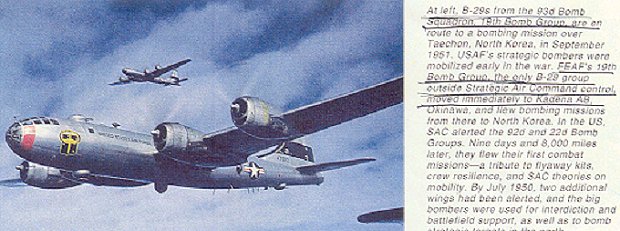 Article and photo from Air Force Times Article and photo from Air Force Times |
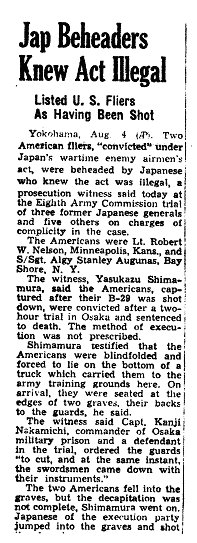 |  |
| On October 19th, 2004, I received an email from Larry Chubet of Sherwood, Maryland, (my first District Sales Manager with Armstrong in 1958) re the preceding article relating the incredible coincidence of his having read the names of those killed by their Japanese captors. Larry's sister Marion is married to Julius (Lou) Augunas and thus, Algernon Stanley Augunas - "Algy" - was the brother of Larry's brother-in-law. Larry had been unaware of any of this story regarding his sister's brother-in law until reading ITAZUKE in NO SWEAT and confirming it with his brother-in-law Lou Augunas. There are apparently thousands of similar personal stories that families have quietly carried the extraordinarily sad burden of for many years! Lou, "The world will little note nor long remember" regarding your brother Algy ... but it is quite enough that WE have and WILL! | |
NO SWEAT # 134 in "outdoor" engine docks for emergency repair at Itazuke AFB in February 1953, two months after we had returned to States. My Left Gunner's position was at the blister just forward of the white "USAF Star-Emblem on side of fuselage. How lithe and graceful she looks even on the ground ... NOT just another "black-bottomed battle-wagon"!I sense the air flowing softly under her weary wings ... and a smooth quiet letdown ... gently "surfing" the darkness between the starry night above and the East China Sea ... and the anxious and almost cheerful interphone chatter within ... as we looked for "Home" ... and GUCKENHEIMER! "THERE ... there a light ... that's it!" "Crew, stand by for landing ... "!
(What else were we gonna do?)
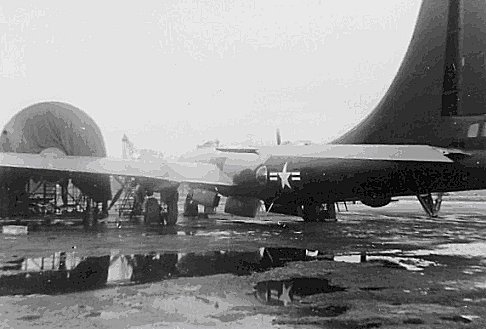 - Photo by Chuck Rees - |
* It was "Snoopy" in the Charlie Brown Comic Strip that first related "COWABUNGA" to surfing ... perhaps expressing that same overwhelming exuberance that we have all felt and expressed in some moment of joy ... and we were to have that moment 24 other times too! Can you feel it? "Cowa ... !"
Chuck Rees at Itazuke AFB, February, 1953 after his return to combat duty from ditching rescue and survival on HALLOWEEN 1952.
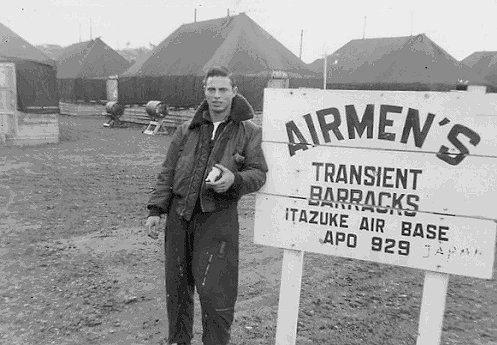 - Photo by Chuck Rees - |
P.S. Those "barracks" were called TENTS but every good intent and effort was made to make the enlisted men feel better, like calling the "chow" food!
Among the list of other "terms of endearment" were "Detail" ... for DIRTY WORK ... "Mess Duty" for K.P. ... . and now instead of "Fatigues" they are called "Utilities" ... and C & K Rations ARE no longer ... now sophisticated "M.R.E.s, Meals Ready To eat" ... just in case you didn't know! And I wonder if they still say "SMOKE 'EM IF YA GOT 'EM" ... or if it's ...
"THE SURGEON GENERAL HAS ISSUED A WARNING THAT CIGARETTES MAY BE HAZARDOUS TO YOUR HEALTH"!
"Ah so", so was the Yalu and by then -at 19 - I was up to 3 to 4 packs a day!
Chuck Rees Email June 2, 2004:
Bud, Thank you for that great article and picture of me. You mentioned in your book about how unwelcome the B-29 crews were in Japan, just 6 years after the A- Bomb....A funny story about this subject happened to our crew ( just the gunners) after we arrived in Japan for the first time.
We arrived in Japan from the U.S. (we were delivering a B-29 # 6446) to Itazuke in Sept of '52, but the base commander said, "we don't need it, take it to Okinawa.!!" So we had a 3 day pass in Tokyo before leaving for Okinawa. Well after we went to town, we soon found out that no one would have anything to do with us. I finally asked a young girl what was the problem, and she said, " you binijku son of a bitch", you bomb my home, kill my mamasan and papasan ... pointing, all the while, to my 20th Air Force shoulder patch. So then we all decided to rip them off. After the patch was gone we all had a great time with the Geisha girls !!!!" ) So a good time was had by all !! Take care, Chuck
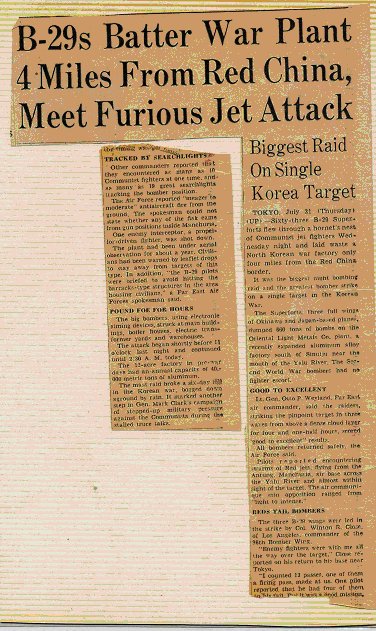 |
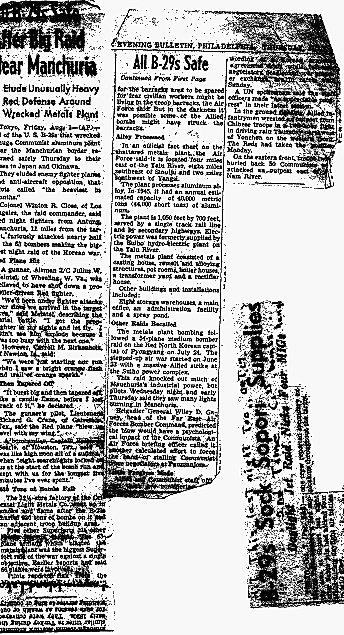 |